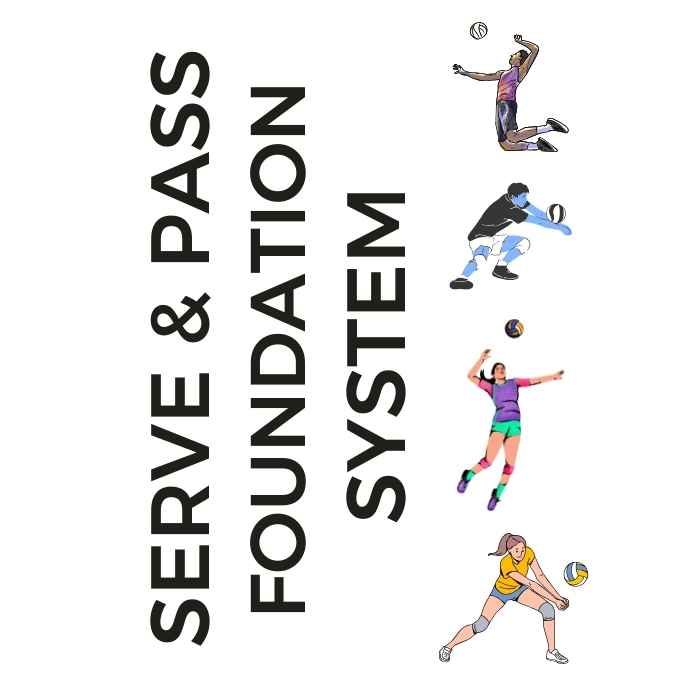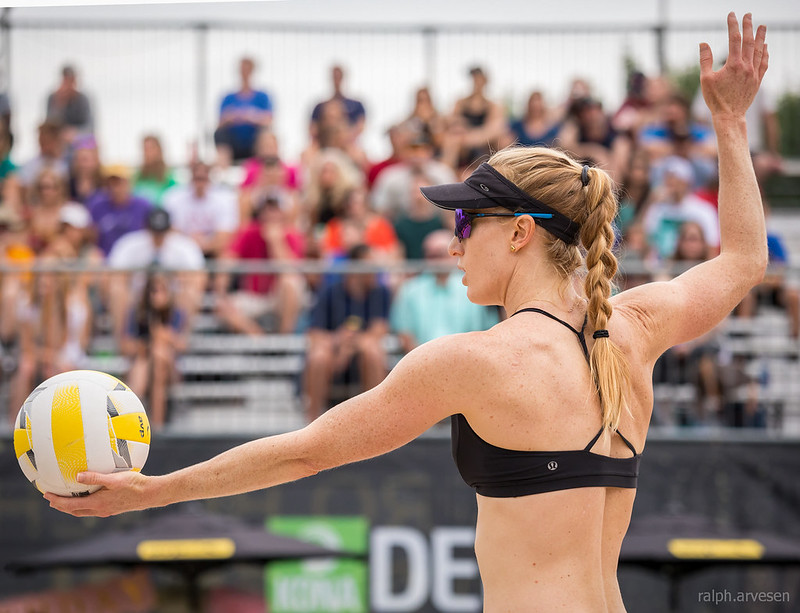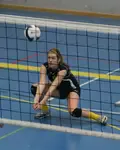
Serve + Pass Foundation System: The Complete Skills Arsenal The two-skill mastery system that transforms inconsistent players into the athletes coaches build their lineups around. Stop Struggling With The Two Most Important Skills In Volleyball!
- Improve Your Volleyball with Coach April
- How To Serve A Floater
- How To Improve Volleyball Serve Skills For Float, Spin and Jump Serves
How To Improve Volleyball Serve Skills For Float, Spin and Jump Serves
On ImproveYourVolley.com find step by step volleyball tips on how to improve volleyball serve skills for standing and jump floater serves and topspin serves.
Learning how to improve volleyball serve skills is crucial when it comes to controlling the game.
Mastering different types of serves- float, spin, and jump can significantly improve your game.
Here's a comprehensive, step-by-step tutorial for each serving style, accompanied by common mistakes to watch out for.
Whether one of the types of volleyballs serves you use is a
- standing float serve,
- jump float serve,
- standing top spin
- jump top spin serve, or underhand serve
...on these pages I tell you about are focused only on how to improve volleyball serve skills, you'll find everything you need to know on Improve Your Volley.com.
What Is Serving In Volleyball? The First Opportunity To Score Points
What is serving in volleyball?
The serve starts each rally and is the first opportunity to score a point. Learn to float serve, underhand, top spin and more.
Ready to take your serving to the next level?
I help future college-bound servers frustrated by slow improvement ...become very good at next-level serving advancement without wasting more months on generic advice with my personalized training that creates measurable serving breakthroughs..
My private training sessions are specifically designed for college-bound athletes who refuse to settle for "good enough" serving.
Limited spots available for serious players only.
How To Improve Volleyball Serve Skills For The Float Serve
A Common Mistake With The Float Serve
Not hitting the ball cleanly in the center of the middle panels of the ball.
This can cause unintended spin, ruining the floating effect.
Step 1:
Stand with your feet shoulder-width apart with the ball in your left hand (or right hand if you're left-handed).
Step 2:
Extend the arm holding the ball out in front of you, while pulling the other arm back behind your ear, ready to swing.
Step 3:
As you swing your arm forward, step forward with the opposite foot, transferring your weight onto it.
The floater is popular because if contacted in the right spot, the ball will dip, float and move as it travels across the net.
Once across, it will just drop straight down making it difficult for a passer to pass it to their target. In my playing career, I've used all types of serves to score points from the service line both in indoor competition and on the beach.
Step 4:
Contact the middle of the ball firmly with the upper middle of your palm, using a flat hand contact which keeps the spin out of the ball. This lack of spin is what gives the serve its floating, unpredictable path.
A Common Mistake With The Float Serve
Not hitting the ball cleanly in the center of the middle panels of the ball.
This can cause unintended spin, ruining the floating effect.
How To Improve Volleyball Serve Skills For The Spin Serve
A 12-year old with a tough top spin jump serve!
Step 1: Stand with feet shoulder-width apart and the ball in your non-dominant hand.
Step 2: Throw the ball up into the air, shifting your weight to your back foot.
Step 3: As the ball begins to drop, swing your arm forward, stepping with your opposite foot.
Step 4:
Contact the ball with a whipping motion, aiming to hit it on your hand's side to achieve spin.
A Common Mistake With The Spin Serve
Hitting the ball straight on rather than on the side, which prevents the side spin and makes the serve easier for opponents to anticipate.
How To Improve Volleyball Serve Skills For The Jump Serve
Ella Serves An Ace Between The Left Back and Middle Back Passers
Step 1: Start by tossing the ball high into the air, a little bit in front of you.
Step 2: Take a three step approach, exactly the way you would for a spike, but with a straight on approach towards the service line.
Step 3: Jump into the air after completing your "step close" step with both feet, raising one arm to contact the ball at the highest point possible
Step 4: Hit the ball as you would with a spike, aiming for a particular area of the court.
A Common Mistake With The Jump Serve
Approaching the serve with a rounded run-up rather than straight or not throwing the ball far enough ahead, causing either a loss of power or directional control.
Why Having Strong Volleyball Serving Skills Gives You More Playing Time
Volleyball Ace: What's An Ace In Volleyball And How To Serve For Points
Learn what are the basic rules dictating how a point can be scored from the service line by using your float serve or jump serve.
Ready to take your serving to the next level?
I help college-bound servers who've tried every tip but still struggle in matches to gain tons of next-level serving confidence without mental breakdowns through personalized training that makes pressure serving feel routine..
My private training sessions are specifically designed for college-bound athletes who refuse to settle for "good enough" serving.
Limited spots available for serious players only.
How To Float Serve And Find Aim and Score Against The Weak Passer
Four Ways To Get An Even More Powerful Jump Float Serve in Volleyball
Overhand Volleyball Serve How Do You Get A Powerful Volleyball Serve?
To control the game with a tough overhand volleyball serve face your target, visualize yourself serving, toss the same way every time, and serve like you spike with an aggressive focused flat hand contact on the ball.
Serving Tips For Volleyball Players To Add More Power To Their Serves
Types of Volleyball Serves What's A Float, Jump Float, Spin, Jump Spin
What're the types of volleyball serves like the standing float serve, the jump float where you add spike approach footwork and the topspin and jump spin serves.
How Many Volleyball Serve Techniques Are There? Learn 5 Serving Terms
How many volleyball serve techniques are there?
Types of Volleyball Serves Topspin, Missile, Coach Kill, Friendly Fire
Topspin, missile, coach kill, friendly fire and husband and wife play are serving terms used for advanced types of volleyball serves used by varsity players.
4 Types of Serves in Volleyball Overhand, Underhand, Topspin and Jump
There are four types of serves in volleyball varsity players learn. Beginners learn the underhand serve first, then the overhand serve, then topspin and jump serve.
The Volleyball Jump Serve Serving Harder To Score Aces in Volleyball
The volleyball jump serve comes in two forms, the jump float serve and the jump topspin, both done by contacting the ball in the air behind the service line.
How to Serve A Floater Known As The Standing Float Serve in Volleyball
Learn how to serve a floater, also called a standing float serve that's hard for the opposing team to pass because of how the ball floats while crossing the net.
A Beach Volleyball Serve Score Aces With A Jump Float Or Topspin Serve
Use your beach volleyball serve like the topspin, float, jump float and sky ball to score points by serving the ball where there are open spaces on the court.
Serving Volleyball Court Zones Score Points With These Serve Tactics
Discover which volleyball court zones like Position 3 and Position 6 to serve to in order to use strategy to score more points and aces from the service line.
Serving in Volleyball Tactics For Scoring Points With Your Float Serve
 Serving in Volleyball Tactics For Scoring Points With Your Float Serve.
On ImproveYourVolley.com find step by step volleyball tips on how to improve volleyball serve skills for standing and jump floater serves and topspin serves.
Serving in Volleyball Tactics For Scoring Points With Your Float Serve.
On ImproveYourVolley.com find step by step volleyball tips on how to improve volleyball serve skills for standing and jump floater serves and topspin serves.When serving in volleyball there are two places where you can serve to on the opposing team's court to increase the chance of scoring points with your serve.
How To Serve A Volleyball A Step By Step Tutorial For Beginners
 How To Serve A Volleyball A Step By Step Tutorial For Beginners
On ImproveYourVolley.com find step by step volleyball tips on how to improve volleyball serve skills for standing and jump floater serves and topspin serves.
How To Serve A Volleyball A Step By Step Tutorial For Beginners
On ImproveYourVolley.com find step by step volleyball tips on how to improve volleyball serve skills for standing and jump floater serves and topspin serves.With this step by step tutorial I teach beginner players how to serve a volleyball because having a tough overhand serve may increase your playing time.
Secrets To A Better Float Serve in Volleyball You High Five The Ball
Many players don't realize it, but the toss for the float serve in volleyball is where many serving errors begin.
Remember, mastering these serves takes time and consistent practice. So don't get discouraged if you don't get it right away.
Keep refining your techniques, and soon, you'll see a significant improvement in your serves.
Ready to take your serving to the next level?
I help goal-oriented servers who want to expand their serving game master multiple serve types without losing their dominant serve through my advanced training that makes your serving highlights stand out to college coaches.
My private training sessions are specifically designed for college-bound athletes who refuse to settle for "good enough" serving.
Limited spots available for serious players only.
Do You Follow Me on Pinterest?
 Private or semiprivate volleyball indoor/sand lessons are an excellent way for young Las Vegas high school volleyball players to quickly improve their individual skills through a private or semi-private coaching experience.
These lessons are conducted by former pro volleyball player, former USA Volleyball High Performance instructor and Evaluator and Tstreet Vegas 18s head Coach April Chapple on a weekly basis.
Sign up now!
Private or semiprivate volleyball indoor/sand lessons are an excellent way for young Las Vegas high school volleyball players to quickly improve their individual skills through a private or semi-private coaching experience.
These lessons are conducted by former pro volleyball player, former USA Volleyball High Performance instructor and Evaluator and Tstreet Vegas 18s head Coach April Chapple on a weekly basis.
Sign up now!Follow me on Pinterest Volleybragswag to improve your game even faster!
I share alot of individual, partner and easy-to-do volleyball serving drills we do in class with my followers.
Many of these volleyball practice drills you can do at home by yourself or try at your next practice with your teammates.
If you're a B team or JV player trying to make varsity next year...your goal should be to complete 1000 reps a day of at least three of the basic skills on your own...volleyball passing, serving and setting should be at the top of the list.
Volleyball Serve Information
Where do you need to go now?
Here are three options:
- Learn more about the volleyball information on Improve Your Volley.com in the Related Links below.
- Follow the suggested reading on our Sitemap page Learning How To Play (Sitemap)
- Or visit the pages in the Information section in the drop down menu at the top of the page.
If your athlete struggles with consistent serve receive, gets subbed out, or is overlooked for playing time—this is the fix you’ve been looking for.

Struggling with passing consistency?
I help talented passers tired of getting pulled from games because of inconsistent serve receive skills BUILD passing confidence without expensive private lessons using the same 3-step system that's helped dozens of my athletes get recruited.
Download my eBook for $17.99 and start building the passing confidence that keeps you on the court—and gets you seen by college coaches.
From Lady Vol to Legend: Coach April Produces Powerful Passionate Players...is that you?
What Are You Looking For?
Click to Download Your Pre Serving Ritual Mastery Checklist pdf:
🎯Volleyball Pre Serving Ritual Guide -
Players! Learn How To Transform Your Serve from Weak to Weapon
Click to Download Your Parent's Volleyball Serving Checklist pdf
🎯Parent's Volleyball Serving Checklist Guide
Parents! Help Your Player Develop Championship Serves (Even If You've Never Played)

Hi there!
Thanks for stopping by. Hope you learned something today that will help you reach your volleyball goals.
Be sure to subscribe to my email newsletter so you can learn more each week!
Stay strong! Stay motivated!
-Coach April

SUSCRIBE to my email newsletter below!
 Click to learn more about the weekly volleyball classes and clinics or email info@imrpoveyourvolley.com for information
Click to learn more about the weekly volleyball classes and clinics or email info@imrpoveyourvolley.com for informationCongratulations to my seven Boys-18s Vegas Volley club players who played in two state championship finals yesterday, the 3A and 5A State champinship finals at Sunrise Mountain High School.
TOURNAMENT CHAMPIONS!
A-1 Vegas Volley VBC
In It To Win It Tournament
May 2 - 4, 2025 Tournament
Gold Medalists
18s Premier Division
Vegas Volleyball's Unsung Heroes: Celebrating Moms with Peace Love Volleyball Shirts
Ready to energize your volleyball mom journey?
Subscribe to my 'Producing Powerful Passionate Peaceful Players' email list above on ImproveYourVolley.com.
You'll receive energy-boosting tips, exclusive insights from me, Coach April Chapple on maintaining momentum in volleyball.
Let's power up the Vegas volleyball scene together!
Recent Articles
-
4 Ways To Improve Volleyball Skills: Your 2026 At-Home Training System
Dec 29, 25 01:14 AM
With these 4 high school volleyball tips I explain ways to improve volleyball skills on your own without the help of your coach in practice and in games. -
Workouts To Improve Volleyball Skills: 4-Week Training Plan & Tracker
Dec 28, 25 09:51 PM
Get complete structured 4-week workouts to improve volleyball skills with daily training schedules, self-assessment checklists, and progress tracking. -
How To Practice Volleyball Alone: Solo Drills That Build Real Skills
Dec 28, 25 06:37 PM
Learn how to practice volleyball alone with wall drills, progressions and weekly one-player training schedules to improve passing, setting, serving & hitting.


























































